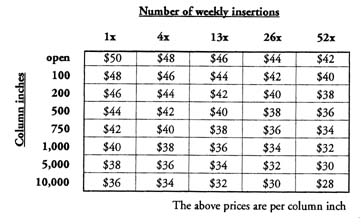
| next page in lesson--> | |
| Lesson
Four: The Rate Card Part 4: Combination of Frequency and Volume Discount |
|
The
Rate Card: Combination of Frequency and Volume Discount
Now, to make things
even more complicated, some newspapers have decided to combine the volume
and frequency discounts. Instead of giving the same discount to someone
who is running a 2x6 for 13 weeks as someone running a 5x14 for 13 weeks,
the account running the larger ad gets an even bigger discount.
Since now there's two variables, this naturally results in all sorts of configurations, and the rates in the rate card are shown in a grid. You'll see a combination frequency and volume discount on this page. If you've ever tried to find your ideal weight on one of those charts where you have to run down one column to find your height displayed and then move across to the right until you find your age and where the two intersect is your ideal weight, then you're familiar with these types of tables.
In our example, the ad sizes in column inches run down the left hand side and the frequency the advertiser is willing to commit to runs along the top row. Simply match the two up and where the columns and rows intersect, that's the rate. For example, if an advertiser runs any size smaller than 100 column inches, one time, then he is charged the open rate of $50 per column inch. The more times he run that ad, the more the price goes down, so if he runs the ad 52 times, the rate will go down to $42.
Using the example,
see if you can find the rate for an advertiser agreeing to run 1,000 column
inches 26 times. Now find the rate for an advertiser agreeing to run 750
column inches 4 times. You get the idea. Most of the rate cards you'll
encounter will contain rate grids that fall into one of these three categories.
If you can read the sample ones in this lesson, you should have no problem
with your own. In many cases, you'll find that for the different products
you sell, the discounts may work in different ways, but they all should
fall into one of the categories I mentioned.
 |
|
|
Sample
combination rate structure (both frequency and volume)
|
|
![]()